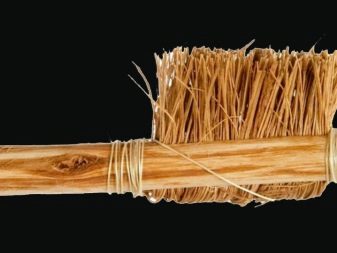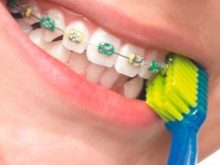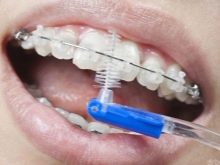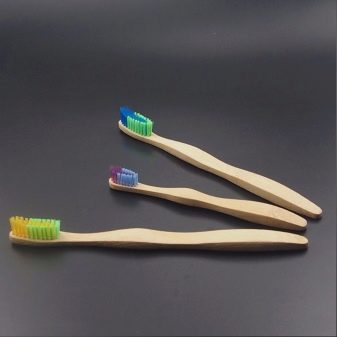Choosing a toothbrush

The toothbrush is the main tool used for oral care. With its help, you can remove bacterial plaque and tartar, return the enamel to its natural color and shine. It is worth talking in more detail about which toothbrushes - manual and disposable, bamboo and ionic, mechanical and electrical, other types - are considered the best, how to choose them correctly.

History of appearance
As the results of archaeological excavations show, even the distant ancestors of modern man did not deny themselves the ability to carry out hygienic procedures. Teeth cleaning at different times was carried out using bone needles, wooden sticks, bark, feathers. Plant resin was used to remove bacterial plaque and inflammation.
The first toothbrush appeared in ancient Egypt. Pharaohs used pieces of cloth or sticks in this capacity.
The invention of devices more or less similar to modern tools for cleaning teeth occurred later. It is known that brushes made of split wood were used in the East as early as the 7th century, and in Russia from about the 9th century. The toothbrush familiar to modern man was invented in 1770 by a British citizen W. Addis. The idea of combining a bone handle with bunches of bristles came to him in very unusual conditions - while serving a prison term.


A rebel by nature, Addis wasted no time in imprisonment. At first, his invention was appreciated by other prisoners in an English prison. In mass production, the toothbrush appeared after its release. In 1780, he patented the invention, and then began industrial production of products.The Wisdom Toothbrushes brand not only glorified the name of its creator over the centuries, but also managed to gain a foothold in the market - the company is successfully operating in the 21st century.
In the United States, the first patent for the production of toothbrushes was issued much later, in the middle of the 19th century. The product was launched into mass production in 1885, and it was made exclusively from natural materials: bones and bristles of wild animals. The quality of the products was not the best: porous hairs promoted the reproduction of pathogenic microflora, did not dry well after cleaning.

Only Oral-B was able to solve this problem. It was she who was the first in the world in 1938 to introduce a toothbrush with synthetic fiber hairs - nylon. Another breakthrough was the introduction of electric oral care tools. This brush was first introduced to the market in 1959.
The 21st century has brought innovation to the process of brushing teeth. In 2012, the United States filed a patent for a disposable brush designed to solve the hygiene problems of travelers and residents of regions where there is no free access to fresh water. No paste or liquid is needed to use it.


Peculiarities
The toothbrush has a fairly simple device. It consists of the following elements:
- handle - can be smooth or ribbed, have rubberized inserts to improve grip;
- the neck connected to the handle - usually has a one-piece construction with it, curved shape, less thickness;
- head - located at the end of the handle and neck, has inserts in the form of bristles of natural or synthetic origin.
Toothbrushes can be of one-piece or composite construction and are made of various materials, mainly of synthetic origin.
The shape of the head is classic - rectangular or round. Such options are most often used by manufacturers of electrical accessories. The main characteristic of toothbrushes is their division according to the degree of hardness.


There are 3 categories.
- Soft / Soft / Sensitive. The softest bristles, suitable for sensitive teeth and gums. All baby brushes belong to this class.
- Medium / Medium. This category includes most of the toothbrushes produced around the world. They are versatile and have moderately stiff bristles. Such indicators are typical for most "adult" brushes.
- Tough / Firm. This class includes products focused on the care of dentures. They have the highest abrasive properties.
All other characteristics of toothbrushes do not matter so much. However, their classification is much broader, and includes a number of other parameters: the location of the bristles, their length and thickness.



Views
It would seem that modern consumers who pay considerable attention to oral hygiene know everything about what toothbrushes are. But a detailed classification may surprise even sophisticated connoisseurs. On sale today are transparent models and options from natural wood, disposable and with a cap, monofilament, coarse and with fine bristles. It is worth learning a little more about all the possible modifications.


Mechanical
The most common brush for cleaning teeth, also called "manual", involves the application of force when processing the enamel surface. The design of such products is extremely simple, they have an integral structure without removable elements, and are subject to regular replacement every 2-3 months. To clean your teeth with a manual brush, you will have to make more effort than using the electric option.
But it costs significantly less, you can choose the design and stiffness of the bristles for every taste.


Treatment-and-prophylactic models can also be attributed to ordinary brushes. They take into account the presence of gum disease or oral cavity. The main difference from the classic manual is the location of the fibers.The bristles have different heights, provide a more delicate effect on the enamel surface, and thoroughly clean difficult areas - in the interdental space, next to the crowns.

Electrical
An automatic toothbrush is powered by self-contained batteries. Its design provides for the presence of a rotating head, which provides a more thorough cleaning and polishing of the enamel. Such products have an impressive weight and require regular replacement of the working unit. Their cost is significantly higher than that of manual ones, but the quality of oral care in this case is also as high as possible.


Ionic
An innovative type of brushes with a special component in the composition.
The titanium dioxide used in them, when wetted with saliva, causes a chemical reaction associated with the attraction of hydrogen molecules.
The surface of the teeth in the process of brushing comes into contact with the generated active oxygen, faster and more efficiently cleaned of impurities. Ionic brushes provide long-lasting antibacterial protection and help reduce the consumption of toothpaste and other products.



Ultrasonic
Specialized brushes, similar to those used in dental offices. They combine the advantages of an electric device and ultrasonic treatment, which allows:
- rid the enamel surface from plaque;
- remove tartar;
- restore the natural shade of the teeth.
Combined with special whitening agents, ultrasonic toothbrushes provide the effect of the procedure, as after visiting a dental office. No paste is required for normal cleaning.
Different attachments provide the most effective cleaning and healing of the oral cavity.


Orthodontic
Professional denture brushes are similar in appearance to regular manual brushes. But their shape and size are somewhat different from the classic ones. Dentists often recommend special brushes for implants and crowns, bridges, and bracket systems. They are more rigid and have a mono-beam structure. Professional options provide a much higher level of hygiene, a special curved handle and narrow head help you to access even the most difficult to reach places.



Manufacturing materials
According to the type of working surface, the classification of toothbrushes is divided into 2 main categories.
- With natural bristles. Such products have high rigidity, and its level cannot be controlled. The bristles are pointed, easily exfoliate, and can damage the mucous membrane. Products are difficult to disinfect or dry completely. Hair accumulates moisture, can dry out, fall out.
- Synthetic. Available with virtually any size, diameter and stiffness of bristles. The hairs have a non-traumatic rounded tip. Synthetic bristle brushes can be chemically decontaminated and mechanically cleaned. They are not afraid of the influence of the external environment.



Besides, the base of the brush also differs significantly in terms of the material of manufacture. Once they were all bone, then wooden. Modern manufacturers most often use various polymer compounds and plastics, which allow the material to provide sufficient rigidity and strength without losing flexibility. Transparent products are obtained from plexiglas, acrylics of different colors.


Combined brushes with a rubber coating or inserts made of high-tech materials are also popular with modern manufacturers. They can have additional surfaces for cleaning the tongue, a more ergonomic handle, or a flexible neck.

The wooden brush has also undergone a noticeable transformation. - today it is bamboo, carbon, with a special coating on the bristles and plant fibers added to a nylon alloy. This product is considered fully biodegradable.


Sizes and shapes
The design of classic manual brushes has remained traditional for centuries. The brush has a handle measuring 10-12 cm, a neck about 5-6 cm, the length of the working part varies depending on the age of the consumer:
- large or adult - 30 mm;
- for children, from 7 years old - 25 mm;
- small or nursery for preschoolers - 2-2.5 cm.
The width of the working head also varies. The usual range is 10 to 12 mm. A distance of about 2.5 mm should be left between the rows of bristles. The optimal shape of the cleaning head is round. Elongated models with sharp corners have less maneuverability.
Electric toothbrushes usually have a round head.


The shape of the neck also varies. She may be:
- straight rigid;
- flexible;
- located at an angle.
The most convenient options are considered to be with an elastic shock absorber, contributing to the correct distribution of the load over the tooth enamel.
These products are considered atraumatic and are suitable for people with hypersensitivity of teeth and gums. In some cases, brushes are used, the head of which is fixed on the neck at an angle of 45 degrees.
The handle has a cylindrical, rectangular shape, the design most often takes into account the ergonomics of the location of the brush in the palm of your hand. There may be rubberized anti-slip inserts on the surface. For electric models, the power button is located here.


Rating of the best models
Not every manufacturer is capable of revolutionizing the toothbrush market. Today, you can find Korean and Japanese, Swiss, Chinese and Russian products from well-known brands on sale. Among them there are both budgetary and very expensive product options.
Budget
Inexpensive toothbrushes are on sale in the widest range. Among them, you can find quite interesting models that cost the owner less than 150-200 rubles.
- Colgate Silk Threads. The black charcoal brush is not only stylish in design. The set includes an ergonomic handle, extra soft bristles, made of silk, have antibacterial dusting. This is a good option, judging by the reviews, for taking care of your teeth after professional brushing.

- Reach Acess Firm. A modern brush with a tapered head at the end and multi-level bristles. The handle is ergonomic, non-slip.

- R. O. C. S. Pro 5490 Gold Edition. Brush with soft synthetic bristles and an eye-catching design. There are models on sale with beige and black countertops. The product is atraumatic, suitable for owners of sensitive teeth.

- Colgate Premier Ultra. An ergonomic and quite beautiful brush with rounded atraumatic bristles. The rows of hairs are arranged to effectively clean even dirt on the chewing teeth. Medium-hard bristles allow most people to use it.

Expensive
In terms of efficiency, expensive brushes of the same class differ little from budget ones. Most often, you have to pay more for unusual design solutions, ergonomics or brand awareness. The top expensive mechanical toothbrushes look like this.
- Radius Original. This brush can easily be given an award for the best design. It has an oversized handle, a transparent colored body and an unusual head angle for easy cleaning. There are brushes for left-handers and right-handers.
- Curaprox Single & Sulciular. A specialized toothbrush for the care of braces and teeth without orthodontic problems. Swiss quality meets stylish design.
- Oral-B Pro Expert All-in-One. Universal brush for cleaning teeth, gums and tongue, there is a wear indicator.



Of course, there are other models of brushes on sale, but these definitely deserve special attention.
Criterias of choice
In order to choose the right toothbrush for adults or children, there are many factors to consider. Among the most important criteria are the following.
- Construction type. The main choice is made between electrical and mechanical options. They are equally suitable for cleaning teeth, but automatic models have a number of contraindications for use.In addition, in this case, it is practically impossible to vary the stiffness of the bristles, and the model range is less diverse. In terms of the quality of cleaning and functionality, the electric brushes outperform conventional models, are suitable for polishing enamel, removing tartar.
- Bristle stiffness. It all depends on the age of the user, the state of health of the oral cavity. The baby brush should only be soft. The same - marked Sensitive - is purchased for sensitive teeth. Medium models suit most people. A doctor will help you choose an option for cleaning braces, prostheses, for hard-to-reach places - such a brush will be the toughest.
- Dimensions. The length of the handle should be such that it fits comfortably in the palm of your hand. It is better to choose the head of an ergonomic shape, with a narrowing and rounding in front. A neck that is too long can interfere with normal oral hygiene.
- Bristle type. The most hygienic option would be a nylon brush or a combination brush with synthetic hairs. Such products are low-traumatic, durable, keep their shape well. Natural pork bristles are practically not used by modern manufacturers.
- Wear indicator / cleaning time. These options help you understand when it is time to change the brush or complete the procedure.

These are the main criteria to rely on when choosing a toothbrush. In addition, it is recommended that you pay attention to the quality of the product's workmanship - it must correspond to the level of the brand and the price.
How to use?
All toothbrushes need to be cared for properly. They also need regular replacement - full or partial, require the creation of optimal storage conditions. Carelessness about personal hygiene items can have serious consequences.

That is why, in the process of using a toothbrush, whether it is a mechanical or an electric version, a number of rules must be followed.
- Clean 2 times a day, in the morning and evening.
- Rinse the brush before use to soften the bristles.
- Measure your toothpaste correctly. A strip 1 cm long is enough for an adult, 0.5 cm for a child.
- Place the bristles at an angle relative to the enamel surface. Move the front teeth strictly vertically, from the mucous membrane. Clean the chewing surfaces in a horizontal plane, without tilting.
- Massage the gums with a soft brush to improve blood circulation.
- Cleanse the tongue at least once a day. Plaque is removed from root to tip.
- Use a toothbrush only for its intended purpose, strictly individually. Avoid contact between the heads of hygiene products during storage.
- Keep upright. Use cases and covers for travel only.
- Rinse the bristles from pasta and food residues after each use.
Visual control is also important. If the set of bristles has lost their shape, elasticity, looks sloppy, thinning of the bunches is noticeable, it is time to change the toothbrush.









